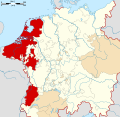Lordship of Overijssel
This article relies largely or entirely on a single source. (November 2012) |
This article needs additional citations for verification. (November 2012) |
Lordship of Overijssel Heerlijkheid Overijssel (nl) | |
|---|---|
| 1528–1798 | |
 Lordship of Overijssel 1757 | |
| Status | State of the Holy Roman Empire (until 1548) part of the Habsburg Netherlands (1548–1588) part of the Dutch Republic (1588–1795) part of the Batavian Republic (from 1795) |
| Common languages | Dutch, West Low German |
| Religion | Catholic Church Protestantism |
| Government | Feudal monarchy |
| Historical era | Middle Ages |
• Established | 1528 |
• Disestablished | 1798 |
The Lordship of Overijssel or Overissel (Latin: Transisalania[1]) is a former division of the Netherlands named for its position along the river Issel.
The lordship was formed in 1528 when Charles V of Habsburg conquered the Oversticht (roughly the present-day Province of Overijssel and Province of Drenthe), during the Guelders Wars. Before 1528, this area was part of the Bishopric of Utrecht. In 1528, at the demand of Henry of the Palatinate, Prince-Bishop of Utrecht, Habsburg forces under Georg Schenck van Toutenburg liberated the Bishopric, which had been occupied by the Duchy of Guelders since 1521–1522. On October 20, 1528, Bishop Henry handed over power to Charles of Habsburg. The Bishopric of Utrecht came to an end and was divided into the Lordship of Utrecht and the Lordship of Overijssel, both ruled by a Habsburg Stadtholder. The name Overijssel however is of much earlier date; Oversticht was known since 1233 by its Latin name Transysla or Transisalania, literally: Over-IJssel, i.e. the other side of the river IJssel.
Between 1528 and 1584, the Stadtholder of Overijssel was the same as the Stadtholder of the Lordship of Frisia. The Lordship became part of the Burgundian Circle by the Pragmatic Sanction of 1549 and one of the Seventeen Provinces.
During the Eighty Years' War, Overijssel was divided between 1580–1597 into a Spanish-controlled part in the East (capital: Oldenzaal) and a republican-controlled part in the West. Both had their own stadtholder. By 1597, the Lordship was reunited by the conquests of Maurice of Nassau, Prince of Orange. Oldenzaal was reconquered by the Spanish in 1605, but definitely lost in 1626.
When the Batavian Republic was created in 1795, the Lordship of Overijssel was abolished. After the Napoleonic Wars came to an end Overijssel was recreated as one of the provinces of United Kingdom of the Netherlands.
References
- ^ Christyn, Jean Baptiste. Histoire Generale Des Pais-Bas: Contenant la Description Des XVII Provinces : Divisée en IV. volumes, augmentée de plusieurs remarques curieuses, de nouvelles figures, & des evenemens les plus remarquables jusqu'à l'an MDCCXLIII. Tome Quatrieme Qui comprend les Provinces d'Hollande, de Zelande, d'Utrecht, de Frise, d'Overissel & de Groningue. Utgiver Foppens, 1743. (in French)


